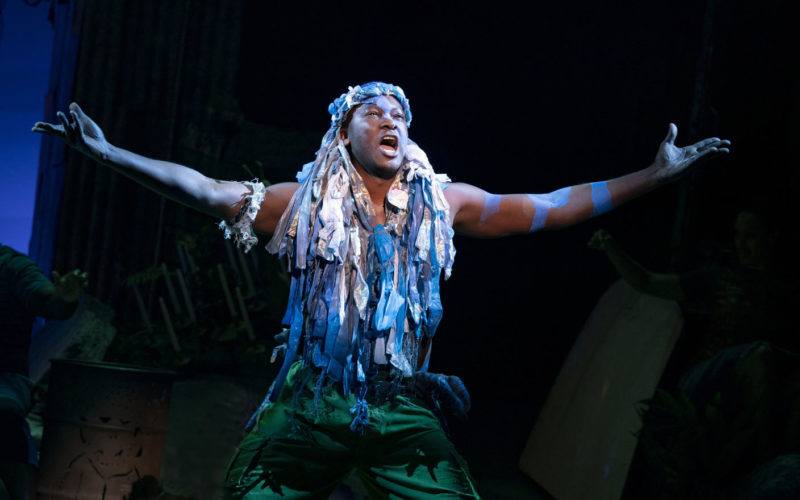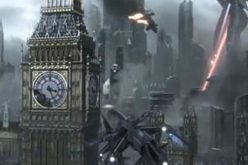In the post-hurricane Caribbean, the inhabitants of “Once on This Island” find their home strewn with trash and other discarded debris that has washed in from the ocean. Tony Award winning costumer designer Clint Ramos was challenged to incorporate such items into his designs to reflect the islanders’ resiliency and resourcefulness after tragedy.
“The people in our show have gone through a natural disaster and are still able to find joy and, as they say, sing and dance and celebrate life,” shares Christopher Vergara, associate costume designer. “That’s what we hope that people can find in the costuming — things that people have said are useless, we find new use in them and bring them life.”
The musical includes a group of gods who rule over the island, and Ramos and his team were prompted to reflect the divine nature of these beings while incorporating those found objects. A group of Arkansas designers was also inspired to give new life to discarded, found and upcycled materials in a design contest conceived by the Walton Arts Center ahead of the musical’s debut in Fayetteville.
“Divinity From the Discarded: A Fashion, Apparel and Garment Design Exhibition” elicited statewide submissions for sustainable garments made from resourced materials. Vergara judged the entries, and the six winning pieces are currently showcased at the WAC. They will remain on display through Feb. 17.
“There is a lot of ingenuity in how to manipulate some of these materials that were used to make these garments,” Vergara says of the submissions he considered. “And it’s fashion, so it’s wearable art. So, how it looks in that lens was also an interesting perspective to the selections.
“How do you create the divine from just the discarded and make commentary about that? That was the vision and the work of Clint Ramos and our director, Michael Arden, and their goal through this work. It was exciting to see that inspire other people to delve into this kind of upcycling fashion.”
The six winners were awarded tickets to “Once on This Island,” showing at the WAC Feb. 11-16, in addition to the distinction of having their work on display at the performing arts center.
Get to know the designers here:
Q. Tell us about the work you presented for the exhibition.
Alyssa Bird: These pieces were part of the collection I came up with for Spring 2019 NWA Fashion Week. This collection was created entirely out of test-print and misprint T-shirts from a local screen printing company, B-Unlimited.
Our mission was about community and utilizing the resources we have in front of us rather than creating something entirely new that will ultimately create more waste. We wanted this to be a collaboration to showcase how working together as a community, with all our different skills and ideas, we can create something much more magical than we can individually.
Trisha Guting: Inspired by ancestor mythologies, tarot symbolism and Pinay ingenuity, “Sagut ni Silaw” (“She Illuminates”), depicts a warrior queen. She is an image of victory and a bringer of light. Through linear and directional shapes and feather detail, she embodies the element of air. Her jewels are both protective armor and noble adornment. Her crown is a beacon of enlightenment.
Sarah White: My piece is a two-piece summer dress knit entirely out of plastic shopping bags. I cut the bags into strips and then knit the fabric.
Q. What inspired this piece?
Elizabeth Koerner: The “fabric” inspired the jacket. I have so much fun designing. I think and pray a lot, and then I get after making a piece. Sometimes the design morphs in the process. This one did. This piece was designed for NWA Fall Fashion Week 2018.
Brandy Lee: I was very inspired by the material itself. The shiny black side looks like a trash bag, and the embossed pattern is similar to what you would see on a window screen. I chose to do a cut-out pattern because the material is stiff and would allow the shape to really stand out. I went with the diamond pattern because it would loosely mimic the embossed pattern. I also chose the glitter vinyl to create a really bright and fun contrast to the black. I made this piece specifically for this exhibition.
Sarah White: I was inspired by traditional dresses Haitian women wear, which have full skirts and are often decorated with rickrack or ribbon. I used different colors of shopping bags to make stripes to evoke that decoration. This was made for this exhibit.
Q. Why is sustainability, upcycling or having eco-conscious practices important to you in your work?
Alyssa Bird: I started my business because my background is in fashion design, and I saw firsthand the mass clothing production process in downtown Los Angeles and was shocked at the amount of excess fabric that gets wasted when the patterns are being cut. I knew I could create something useful from this waste and prevent it from going to a landfill, so I started making unique wearable art accessories.
Trisha Guting: I started upcycling and repurposing materials out of necessity due to cost or availability constraints. But watching people interact with my work has taught me the material is valuable in more ways than just my budget. There is an inherent beauty in transformation. Viewers appreciate seeing “useless”/used up objects in a new way. It’s like the opposite feeling of seeing litter on the bike trail. It sparks their imagination and helps them start seeing solutions instead of just feeling overwhelmed by our massive global trash problem.
Rosie Rose: Fashion is one of the top polluters of all industries. I am only a small indie brand, but I think we can all make a difference, and we should all be trying to make a difference however possible. Some other ways I try to promote eco-friendly practice in my designs are saving scraps and remnants and making things with them; dyeing fabric in small batches so there is as little waste as possible; creating high-quality garments designed to last a lifetime; and offering my customers free repairs so that if something is damaged it will be fixed and returned to their closet, rather than thrown away.
Sarah White: Using discarded materials really appeals to me because we live in a culture that is so comfortable with using things for a brief period and then discarding them. While the average person is not going to make a garment out of plastic bags, I think this project is an interesting way to look at being mindful of the short time we actually use a lot of products that come into our home and considering creative ways that we can reuse or extend the life of different products instead of just throwing them away.
Q. What embodies divinity for you in your own work?
Elizabeth Koerner: When God gives creativity in exciting and inspiring ideas, the pieces that end up on the runway really do reflect divinity to me. It would be wonderful if this jacket caused another person’s creativity to run a little bit wild. Inspiring another would be delightful. Interesting materials, shapes, textures challenge and inspire me.
Brandy Lee: I feel divinity from the work itself. Creating something from nothing gives me the most pleasure. Divinity for me in my work comes from working extremely hard to create work that doesn’t look “handmade.” The attention to detail is absolutely key in my work. Every stitch, every cut and every placement is important. I rarely say “No” to a project so I am constantly being pushed to learn more and hone my craft.
Rosie Rose: I think there is nothing more divine than when a garment joins the person meant to wear it, and it fits perfectly. Clothing is an interesting art form in that respect. It is not truly finished until it is worn by a human being. The person and the clothing together make a complete work of art.
JOCELYN MURPHY
jmurphy@nwadg.com
__
FAQ
‘Divinity from the Discarded:
A Fashion, Apparel and Garment Design Exhibition’
WHEN — Through Feb. 17
WHERE — Walton Arts Center in Fayetteville
COST — Free
INFO — 443-5600, waltonartscenter.org
__
FAQ
‘Once on This Island’
WHEN — 8 p.m. Feb. 14; 2 & 8 p.m. Feb. 15; 2 p.m. Feb. 16
WHERE — Walton Arts Center in Fayetteville
COST — $25-$81
INFO — 443-5600, waltonartscenter.org
BONUS — On-stage tickets are available. These seats offer a side/rear view of some of the performance as they are on the sides of the stage.
FYI — The performance runs approximately 90 minutes without an intermission.










